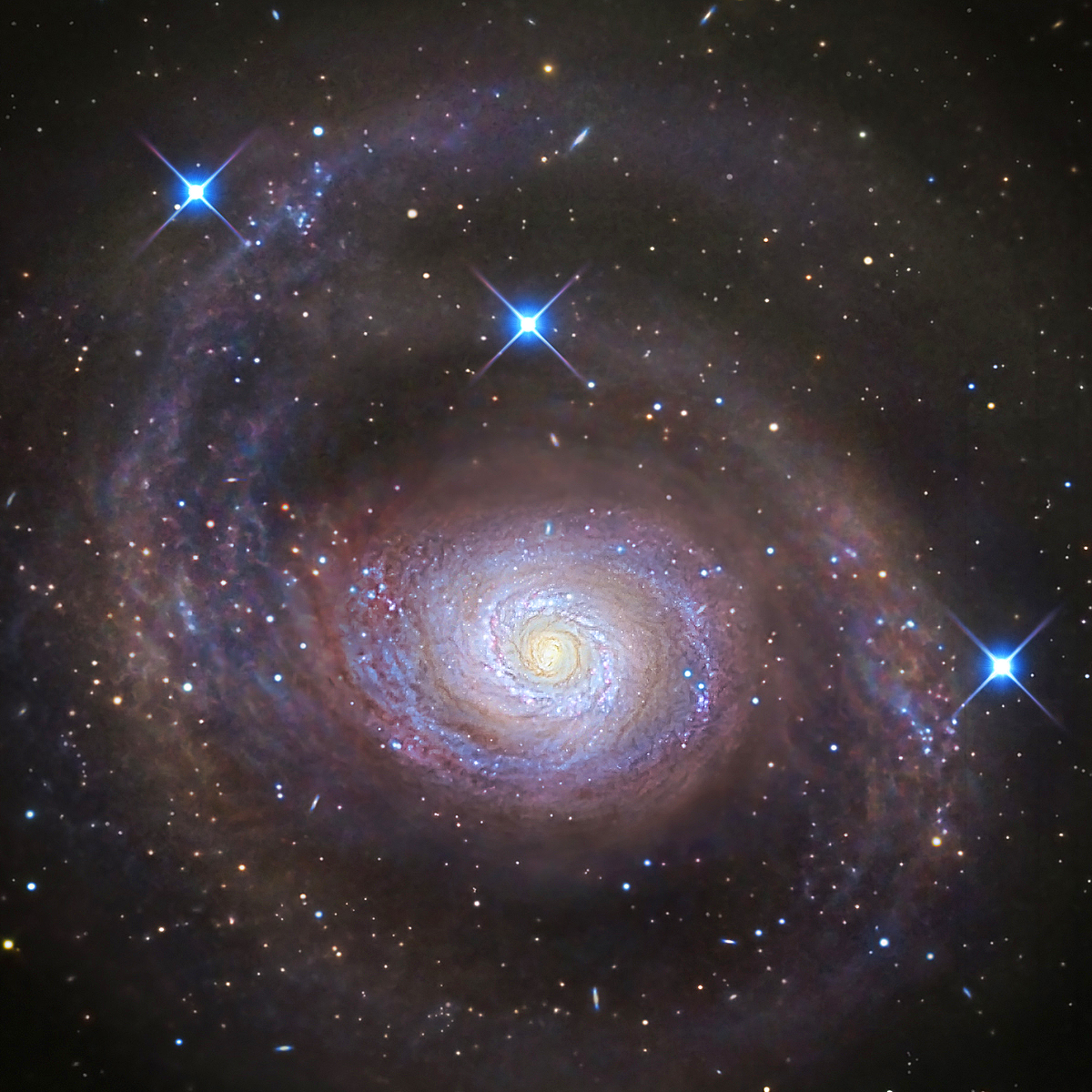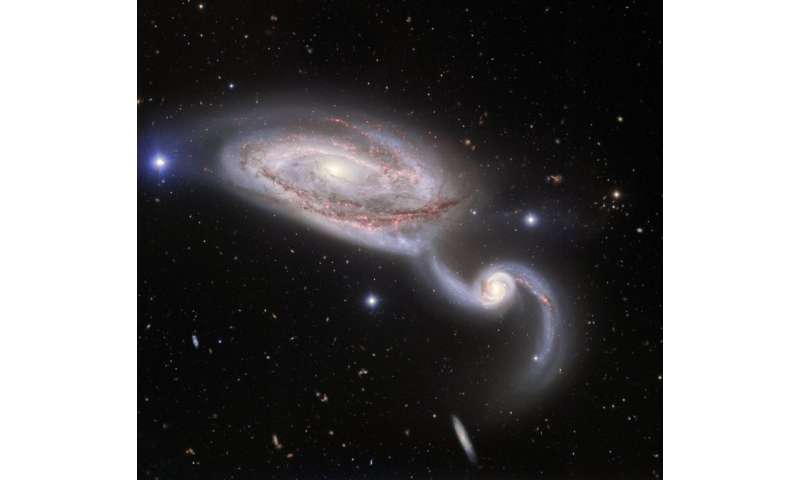|
|
Post by MartinT on Sept 7, 2019 21:30:52 GMT
That's a stunning photo.
|
|
|
|
Post by jandl100 on Sept 28, 2019 4:43:03 GMT
a thought for the day  |
|
|
|
Post by jandl100 on Oct 22, 2019 9:21:25 GMT
|
|
|
|
Post by jandl100 on Oct 29, 2019 8:59:48 GMT
|
|
|
|
Post by MartinT on Oct 29, 2019 10:08:41 GMT
Slow-motion mayhem!
|
|
|
|
Post by jandl100 on Oct 29, 2019 12:10:54 GMT
I know what you mean, but it's slow motion at hundreds of km/second - galaxies are so damn big the motion seems imperceptible.
|
|
|
|
Post by jandl100 on Nov 1, 2019 6:37:32 GMT
Galaxy collisons are for wimps. Here are four clusters of galaxies in the process of merging. "Four huge galaxy clusters, each with a mass of at least several hundred trillion times that of the sun, are in the process of merging to form one of the most massive systems in the known universe."  astronomynow.com/2019/10/31/four-galaxy-clusters-merging-in-massive-collision/ astronomynow.com/2019/10/31/four-galaxy-clusters-merging-in-massive-collision/Here we have a slow motion pile-up at around 500 miles a second (2,000,000 mph). It will take billions of years for the merger into one giant cluster of galaxies. They are around 3 billion light years away from us. So we are seeing them as they were 3 billion years ago - I guess the merger is pretty much complete by now in their own frame of reference. |
|
|
|
Post by MartinT on Nov 1, 2019 6:57:52 GMT
each with a mass of at least several hundred trillion times that of the sun . . at around 500 miles a second (2,000,000 mph). It's incomprehensible, really. |
|
|
|
Post by jandl100 on Nov 17, 2019 14:38:21 GMT
 'The Star Streams of NGC 5907. Grand tidal streams of stars seem to surround galaxy NGC 5907. The arcing structures form tenuous loops extending more than 150,000 light-years from the narrow, edge-on spiral, also known as the Splinter or Knife Edge Galaxy. Recorded only in very deep exposures, the streams likely represent the ghostly trail of a dwarf galaxy - debris left along the orbit of a smaller satellite galaxy that was gradually torn apart and merged with NGC 5907 over four billion years ago. Ultimately this remarkable discovery image, from a small robotic observatory in New Mexico, supports the cosmological scenario in which large spiral galaxies, including our own Milky Way, were formed by the accretion of smaller ones. NGC 5907 lies about 40 million light-years distant in the northern constellation Draco. - Astronomy picture / November 16, 2019' |
|
|
|
Post by MikeMusic on Nov 17, 2019 16:39:45 GMT
Real Science Fiction
Was it Hitch Hikers that said.....
Yes
“Space is big. You just won't believe how vastly, hugely, mind-bogglingly big it is. I mean, you may think it's a long way down the road to the chemist's, but that's just peanuts to space.”
― Douglas Adams, The Hitchhiker's Guide to the Galaxy
Incomprehensible
|
|
|
|
Post by jandl100 on Nov 20, 2019 7:39:35 GMT
 '[Arp 273: Battling Galaxies from Hubble ] What's happening to these spiral galaxies? Although details remain uncertain, there sure seems to be a titanic battle going on. The upper galaxy is labelled UGC 1810 by itself, but together with its collisional partners is known as Arp 273. The overall shape of the UGC 1810 -- in particular its blue outer ring -- is likely a result of wild and violent gravitational interactions. The blue color of the outer ring at the top is caused by massive stars that are blue hot and have formed only in the past few million years. The inner part of the upper galaxy -- itself an older spiral galaxy -- appears redder and threaded with cool filamentary dust. A few bright stars appear well in the foreground, unrelated to colliding galaxies, while several far-distant galaxies are visible in the background. Arp 273 lies about 300 million light years away toward the constellation of Andromeda. Quite likely, UGC 1810 will devour its galactic sidekicks over the next billion years and settle into a classic spiral form.' |
|
|
|
Post by jandl100 on Nov 24, 2019 7:01:18 GMT
The later stages of a 3 way galaxy collision - and the super massive black holes that were at the centre of each galaxy have been detected within a mere 3,000 light years of each other, each one is >90 million solar masses. They will likely merge within a few million years to become the central focus of the giant galaxy that will form and settle down to 'normality' over the next billion years or so.  NGC 6240 is an ongoing collision between three galaxies about 300 million light years away. Hard X-rays from two sources near the center of the merging galaxies indicated the presence of two supermassive black holes. Astronomers have now found a third. astronomynow.com/2019/11/23/a-galactic-train-wreck-with-three-supermassive-black-holes/ |
|
|
|
Post by MartinT on Nov 24, 2019 11:20:16 GMT
Bad luck for any civilisation in the path of those x-rays.
|
|
|
|
Post by jandl100 on Nov 27, 2019 9:14:12 GMT
What an amazing image. This galaxy is a real mystery.  "[Hoags Object: A Nearly Perfect Ring Galaxy ] "[Hoags Object: A Nearly Perfect Ring Galaxy ]
Is this one galaxy or two? This question came to light in 1950 when astronomer Arthur Hoag chanced upon this unusual extragalactic object.
On the outside is a ring dominated by bright blue, younger stars, while near the center lies a ball of much redder stars that are likely much older. Between the two is a gap that appears almost completely dark.
How Hoag's Object formed, including its nearly perfectly round ring of stars and gas, remains unknown. Genesis hypotheses include a galaxy collision billions of years ago and the gravitational effect of a central bar that has since vanished.
The photo was taken by the Hubble Space Telescope and recently reprocessed using an artificially intelligent de-noising algorithm. Observations in radio waves indicate that Hoag's Object has not accreted a smaller galaxy in the past billion years.
Hoag's Object spans about 100,000 light years and lies about 600 million light years away toward the constellation of the Snake (Serpens). Many galaxies far in the distance are visible toward the right, while coincidentally, visible in the gap at about seven o'clock, is another but more distant ring galaxy." |
|
|
|
Post by MartinT on Nov 27, 2019 9:43:13 GMT
Beautiful and fascinating. 100,000 light years across? <boggle>
|
|
|
|
Post by jandl100 on Nov 29, 2019 20:02:05 GMT
 The two galaxies in this image taken by Hubble, named NGC 6285 (left) and NGC 6286 (right), have strayed a little too close. Together, the duo is named Arp 293 and they are interacting, their mutual gravitational attraction pulling wisps of gas and streams of dust from them, distorting their shapes, and gently smudging and blurring their appearances on the sky |
|
|
|
Post by MartinT on Nov 29, 2019 22:46:13 GMT
Amazing combined mass and yet gravity is such a weak force in the scheme of things.
|
|
|
|
Post by jandl100 on Dec 1, 2019 8:39:31 GMT
The peculiarities of this galaxy are (probably) not the result of a collision with another galaxy, but it's a fascinating and very pretty one! [Starburst Galaxy M94 from Hubble ] Why does this galaxy have a ring of bright blue stars? Beautiful island universe Messier 94 lies a mere 15 million light-years distant in the northern constellation of the Hunting Dogs (Canes Venatici). A popular target for Earth-based astronomers, the face-on spiral galaxy is about 30,000 light-years across, with spiral arms sweeping through the outskirts of its broad disk. But this Hubble Space Telescope field of view spans about 7,000 light-years across M94's central region. The featured close-up highlights the galaxy's compact, bright nucleus, prominent inner dust lanes, and the remarkable bluish ring of young massive stars. Within the bright ring new stars are forming at a high rate and many young, bright stars are present within it – thanks to this, this feature is called a starburst ring. The ring stars are all likely less than 10 million years old, indicating that M94 is a starburst galaxy that is experiencing an epoch of rapid star formation. The cause of this peculiarly shaped star-forming region is likely a pressure wave going outwards from the galactic centre, compressing the gas and dust in the outer region. The compression of material means the gas starts to collapse into denser clouds. Inside these dense clouds, gravity pulls the gas and dust together until temperature and pressure are high enough for stars to be born. Credit: ESA/Hubble & NASA  And the whole of the M94 galaxy is shown in the photo below. It looks to me that the outer regions are in a very disturbed state, so I do wonder if some form of galaxy-galaxy encounter has disrupted it.  |
|
|
|
Post by jandl100 on Dec 15, 2019 7:04:03 GMT
NGC 5394/5, sometimes nicknamed the Heron Galaxy. This image, obtained by the Gemini Observatory of NSF's National Optical-Infrared Astronomy Research Laboratory. The two galaxies have already collided at least once. One byproduct of the turbulence caused by the interaction is the coalescence of hydrogen gas into regions of star formation. In this image, these stellar nurseries are revealed in the form of the reddish clumps scattered in a ring-like fashion in the larger galaxy (and a few in the smaller galaxy). These interacting spiral galaxies are 160 million light-years from Earth in the constellation of Canes Venatici. The larger galaxy, NGC 5395 (on the left), is 140,000 light-years across and the smaller one, NGC 5394, is 90,000 light-years across.  |
|
|
|
Post by MikeMusic on Dec 15, 2019 10:57:20 GMT
The enormity of it all
All mind boggling.
|
|